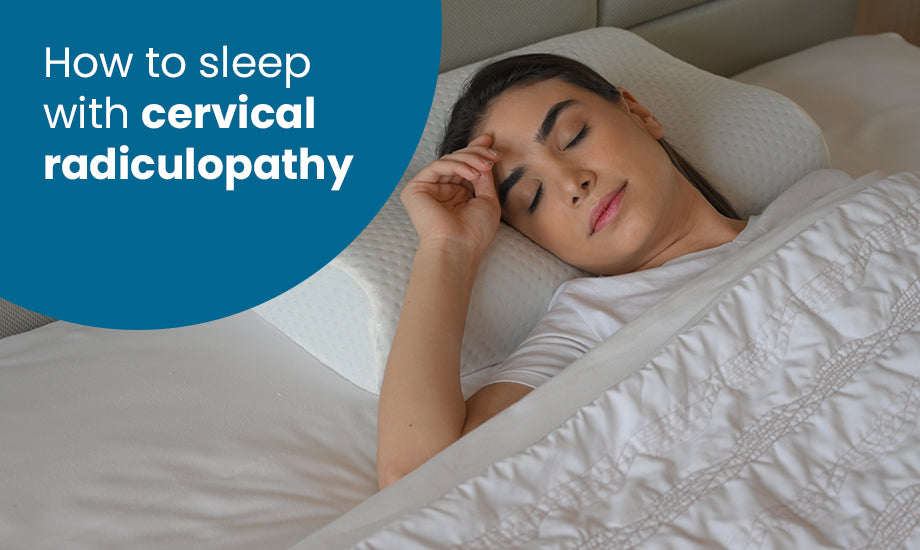
Before understanding cervical radiculopathy, it is important to first understand the anatomy of the back bone ( the spine). The spine comprises of 33 bones, known as vertebrae. Each vertebrae lie on top of the other vertebrae. The vertebrae can be divided into : cervical ( 7 vertebrae), thoracic (12 vertebrae), lumbar(5 vertebrae), sacral ( 5 vertebrae which are fused together)and coccygeal (4 vertebra which are fused together, the tailbone). The 24 upper vertebrae are separated by interposition of a vertebral disc between adjacent vertebrae. Each vertebrae is hollow in the middle forming the spinal canal. The spinal cord is present in this canal. Nerves present in the spinal canal come out via openings present in the vertebrae.
What is Cervical Radiculopathy?
Cervical radiculopathy or “ pinched nerve” , a neurologic condition, refers to the compression or irritation of any cervical nerve root leading to altered functioning of the nerve. It may be caused due to bone spurs and degeneration or herniated disc. According to studies, the 7th cervical nerve root (C6-7 herniation) is mostly affected (in 60% cases). Impingement of the nerve root likely causes nerve damage by chemical and mechanical pathways. Although disc herniation is one of the causes of nerve compression , in most of the cases cervical radiculopathy occurs because of cervical spondylosis.
Causes of cervical radiculopathy
- Degenerative changes
- Spinal infections
- Spinal tumors
- Due to injury
- Sarcoidosis
Symptoms of cervical radiculopathy
According to studies, there is usually mild, intermittent symptoms or the patient is asymptomatic. The symptoms are usually unilateral (present only on one side). Patients may present with symptoms like:
- Dull or sharp neck pain. which may also be present in the arm (or both symptoms may be present). According to earlier studies, the pain worsens when the patient sleeps or during any movement
- Numbness or tingling in the arm and hand
- Loss of coordination and loss of reflexes in arms.
- Sensation loss in neck, hands or arms
- Weakness in hand, arm and shoulder
Diagnosis of cervical radiculopathy
- Review of the symptoms and history of the patient by the physician.
- X-ray
- Magnetic resonance imaging (MRI)
- Computed tomography (CT scan)
- Electromyography
Treatment of cervical radiculopathy
Cervical radiculopathy is mostly self limiting and conservative management is sufficient to control it. The types of treatment can be divided into:
1) Non operative treatments
- Physical therapy: Includes immobilization, intermittent traction of cervical region, infrared and ultrasound treatments, ergonomic and postural training. Many studies have found stretching and strength training of neck muscles to be useful.
- Immobilization is done by using cervical collars
- Manipulation: A recent study showed that immediate pain responded better to manipulation compared to immobilization. However, at intermediate and short term follow up, no benefit was found. Such uncertain benefits can potentially lead to serious complications existing with cervical manipulation.
- Traction: Traction weights can range from 5 to 12 kgs. It may be given alone or together with other exercise regimens.
- Cervical steroid injection: Used together with the other non operative treatments. Although rare, there may be minor or major complication in this procedure.
- Medications: Mainly analgesics are used which can be broadly classified into non narcotic and narcotic medications. The physician should always try to avoid narcotic medications. Amongst the non narcotic medications, NSAIDs ( non steroidal anti inflammatory drugs) are mostly used. Oral corticosteroids are also used at times to manage the inflammation of acute phase. The benefits of corticosteroid use must be weighed against the risks following their use.
2) Surgical treatment
How to sleep with cervical radiculopathy
Improper sleeping posture of cervical spine can aggravate the symptoms of cervical radiculopathy.. Finding a sleeping posture that is comfortable and pain free is pften difficult. Pillows play an important role in proper, pain free sleep..
- Sleeping on back: it is the easiest way to position the neck and head properly. Using a pillow that reinforces the neck curvature with a flatter part to support head is important.
- Sleeping on the side: the first position is more preferable although sleeping on side is better than sleeping on stomach. The most important thing is using a tall pillow so that the head and neck are perfectly lined up which will ensure that the spine is straight while sleeping.
- Sleeping on stomach: this position is not recommended. However, in case the patient is comfortable sleeping only in this position, it is important to sleep without a pillow or sleep with a very thin pillow.
- Sleeping upright: this is a useful position. Compared to traditional pillow, the patient should use a sing a U-shaped pillow that goes around the neck together with a small pillow that will support the lower back.
Cervical radiculopathy can affect sleep and other daily activities thereby compromising the quality of life of the patient. However, with proper treatment and following the advised sleeping techniques the discomfort can be reduced.












